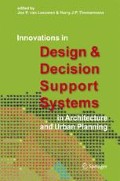Access this chapter
Tax calculation will be finalised at checkout
Purchases are for personal use only
Preview
Unable to display preview. Download preview PDF.
References
Cole, H. and D. Stanton, 2003, “Designing mobile technologies to support co-present collaboration”. Personal and Ubiquitous Computing, 7 (6), ACM/Springer.
Dourish, P., 2001, Where the Action Is?: The foundations of embodied interaction, MIT Press.
Fatah gen. Schieck, A., I. Lopez de Vallejo and A. Penn, 2005, “Urban Space and Pervasive Systems”. 7th Intl Conference on Ubiquitous Computing, Tokyo. Japan, (poster).
Feenberg, A., 1999, Questioning Technology, Routledge.
Forsyth, M., 2004, Bath, Yale University Press.
Gaver, W., 1996, “Affordances for interaction: The social is material for design”. Ecological Psycholog, 8(2).
Green, L., 2002, Communication, technology and society. London: SAGE.
Harrison, H. and P. Dourish, 1996, “Replaceing space: the roles of place and space in collaborative systems”. Computer Supported Cooperative Work, Massachusetts, USA.
Hillier, B., 1996, Space is the Machine, Cambridge Press.
Hillier, B., R. Burdett, Peponis, J., and Penn, A., 1987, “Creating life: or, does architecture determine anything? ” Architecture and Behaviour, 3(3).
Hillier, B., 2000, “The Common Language of Space: a Way of Looking at Social, Economic and Environmental functioning of Cities on a Common Basis”, University College London.
Hillier, B. and J. Hanson, The Social Logic of Space, 1984, Cambridge University Press.
Hillier, B., A. Penn, J. Hanson, T. Grajewski and J. Xu, 1993, “Natural movement; or, configuration and attraction in urban space use”, Environment and Planning B. Ito, M., D. Okabe and M. Matsuda, eds., 2005, Personal, Portable, Pedestrian: Mobile Phones in Japanese Life. Cambridge: MIT Press.
Kostakos, V. (2005). A design framework for pervasive computing systems. PhD. Thesis, University of Bath, UK. Technical Report CSBU2005-02, ISSN 1740-9497.
Kostakos, V. and E. O’Neill, 2004, “Pervasive computing in emergency situations”, 37 Annual th Hawaii Intl Conference on System Sciences, IEEE Press.
Krogh, P.G., 2000, “Interactive Rooms –augmented reality in an architectural perspective”, DARE 2000, Elsinore Denmark.
McCullough, M., 2004, Digital Ground: Architecture, Pervasive Computing, and Environmental knowing. MIT Press, Cambridge, MA.
O’Neill, E., P. Johnson and H. Johnson, 1999, “Representations and user-developer interaction in cooperative analysis and design”. Human-Computer Interaction, 14(1).
O’Neill, E., D. Woodgate and V. Kostakos, 2004, “Easing the wait in the Emergency Room: designing public information systems”. ACM Designing Interactive Systems, Boston, MA.
Penn A., C. Mottram, A. Fatah gen. Schieck, M. Witkämper, M. Störring, O. Romell, A. Strothmann and F. Aish, “Augmented Reality meeting table: a novel multi-user interface for architectural design”, DDSS 2004, Kluwer Academic Publishers.
Read, S., 1997, “Space syntax and the Dutch city”, 1st Intl Space Syntax Symposium, UK. Rodden, T. and S. Benford, 2003, “The evolution of buildings and implications for the design of ubiquitous domestic environments”. CHI 2003, USA. CHI Letters 5(1).
Streitz, N.A., J. Geissler and T. Holmer, 1998, “Integrated design of architectural spaces and information spaces”. 1st Intl Workshop on Cooperative Buildings, Darmstadt, Germany.
Weiser, M., 1991, “The Computer for the 21st Century”, Scientific American, 265(3).
Weiser, M. and S.J. Brown, 1996, The Coming Age of Calm Technology, Xerox PARC.
Wisneski, C., H. Ishii, A. Dahley, M. Gorbet, S. Brave, B. Ullmer and P. Yarin, 1998, “Ambient displays: turning architectural space into an interface between people and digital information”. 1st Intl Workshop on Cooperative Buildings, Darmstadt, Germany.
Author information
Authors and Affiliations
Editor information
Editors and Affiliations
Rights and permissions
Copyright information
© 2006 Springer
About this paper
Cite this paper
gen Schieck, A.F. et al. (2006). Design Tools for Pervasive Computing in Urban Environments. In: Van Leeuwen, J.P., Timmermans, H.J.P. (eds) Innovations in Design & Decision Support Systems in Architecture and Urban Planning. Springer, Dordrecht. https://doi.org/10.1007/978-1-4020-5060-2_30
Download citation
DOI: https://doi.org/10.1007/978-1-4020-5060-2_30
Publisher Name: Springer, Dordrecht
Print ISBN: 978-1-4020-5059-6
Online ISBN: 978-1-4020-5060-2
eBook Packages: EngineeringEngineering (R0)

